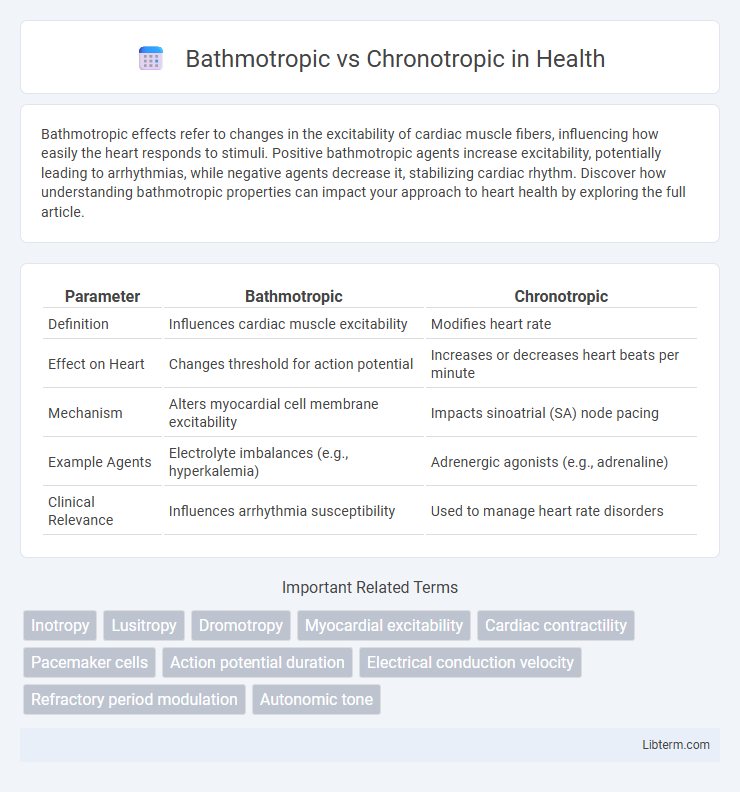Bathmotropic effects refer to changes in the excitability of cardiac muscle fibers, influencing how easily the heart responds to stimuli. Positive bathmotropic agents increase excitability, potentially leading to arrhythmias, while negative agents decrease it, stabilizing cardiac rhythm. Discover how understanding bathmotropic properties can impact your approach to heart health by exploring the full article.
Table of Comparison
| Parameter | Bathmotropic | Chronotropic |
|---|---|---|
| Definition | Influences cardiac muscle excitability | Modifies heart rate |
| Effect on Heart | Changes threshold for action potential | Increases or decreases heart beats per minute |
| Mechanism | Alters myocardial cell membrane excitability | Impacts sinoatrial (SA) node pacing |
| Example Agents | Electrolyte imbalances (e.g., hyperkalemia) | Adrenergic agonists (e.g., adrenaline) |
| Clinical Relevance | Influences arrhythmia susceptibility | Used to manage heart rate disorders |
Introduction to Bathmotropic and Chronotropic Effects
Bathmotropic effects refer to changes in the excitability of cardiac muscle fibers, influencing how easily heart cells respond to stimuli. Chronotropic effects involve alterations in heart rate, either increasing or decreasing the frequency of cardiac contractions. Both bathmotropic and chronotropic effects play crucial roles in modulating cardiac function and are essential in understanding how various drugs and physiological conditions impact heart performance.
Defining Bathmotropy: What Does It Mean?
Bathmotropy refers to the influence on the excitability of cardiac muscle fibers, directly affecting the threshold for triggering action potentials. Unlike chronotropy, which describes changes in heart rate, bathmotropic effects modify how easily heart cells respond to electrical stimuli, impacting arrhythmogenesis and cardiac conduction. Understanding bathmotropic mechanisms is crucial for managing conditions involving altered myocardial excitability and responsiveness.
Understanding Chronotropy: Key Concepts
Chronotropy refers to the regulation of heart rate by influencing the sinoatrial node's pacing, which directly affects the frequency of cardiac contractions. Positive chronotropic effects increase heart rate through sympathetic stimulation and increased calcium ion influx, while negative chronotropic effects decrease heart rate via parasympathetic activation and reduced calcium availability. Understanding chronotropy is crucial for managing arrhythmias and optimizing cardiac output in various clinical settings.
Bathmotropic vs Chronotropic: Core Differences
Bathmotropic effects influence the excitability of cardiac muscle cells by altering their threshold for action potential generation, directly impacting the heart's responsiveness to stimuli. Chronotropic effects specifically regulate the heart rate by modifying the firing rate of the sinoatrial node, thus controlling the timing of heartbeats. The core difference lies in bathmotropic changes affecting cellular excitability, while chronotropic changes primarily affect the timing and frequency of heart contractions.
Molecular Mechanisms Behind Bathmotropic Actions
Bathmotropic effects primarily influence the excitability of cardiac muscle cells by modulating ion channel function, particularly voltage-gated sodium channels, which alter the threshold potential for action potential initiation. These molecular mechanisms involve changes in the gating kinetics and conductance of sodium channels, often mediated by phosphorylation states and intracellular calcium levels that modify channel sensitivity. Bathmotropic modulation impacts myocardial responsiveness to stimuli, thereby affecting the likelihood of arrhythmogenic events through altered action potential propagation.
Molecular Mechanisms Behind Chronotropic Responses
Chronotropic responses are primarily regulated by the modulation of pacemaker cell ion channels, including the upregulation of funny current (I_f) through hyperpolarization-activated cyclic nucleotide-gated (HCN) channels by cyclic AMP. Beta-adrenergic stimulation enhances intracellular cAMP levels, activating protein kinase A (PKA) which phosphorylates L-type calcium channels, increasing calcium influx and accelerating depolarization rates. Bathmotropic effects, in contrast, involve changes in myocardial excitability through altered sodium channel function, affecting action potential threshold rather than heart rate modulation linked to chronotropic activity.
Clinical Significance of Bathmotropic and Chronotropic Effects
Bathmotropic effects influence the excitability of cardiac muscle fibers, altering the threshold for action potential generation, which is crucial in managing arrhythmias and preventing abnormal heart rhythms. Chronotropic effects modify heart rate by impacting the sinoatrial node's pacemaker activity, playing a vital role in treatments for bradycardia or tachycardia. Clinically, understanding bathmotropic and chronotropic properties helps optimize pharmacological interventions such as beta-blockers and calcium channel blockers to maintain cardiovascular stability.
Drugs Influencing Bathmotropic Activity
Drugs influencing bathmotropic activity primarily affect the excitability of cardiac muscle cells by altering the threshold potential, which impacts the heart's response to stimuli. Agents such as digitalis increase bathmotropy by enhancing sodium-potassium ATPase inhibition, leading to increased intracellular calcium and heightened myocardial excitability. Conversely, drugs like quinidine reduce bathmotropic effects by stabilizing the cell membrane and raising the threshold for action potential generation, thereby decreasing cardiac excitability.
Medications and Agents Affecting Chronotropic Processes
Medications affecting chronotropic processes primarily target heart rate modulation through agents like beta-blockers, which decrease sympathetic stimulation and reduce heart rate, and calcium channel blockers, which slow atrioventricular node conduction. Positive chronotropic drugs, such as atropine and certain sympathomimetic agents, increase heart rate by inhibiting parasympathetic influence or stimulating adrenergic receptors. Understanding the pharmacodynamics of these agents is crucial for managing arrhythmias, tachycardia, and bradycardia within clinical cardiology.
Comparing Therapeutic Implications: Bathmotropic vs Chronotropic
Bathmotropic effects influence cardiac excitability by altering the threshold for action potential generation, which is crucial in managing arrhythmias through agents that modify myocardial responsiveness. Chronotropic effects regulate heart rate by affecting the sinoatrial node's pacing, making chronotropic drugs essential for treating bradycardia or tachycardia. Therapeutic strategies often combine bathmotropic and chronotropic modulation to optimize cardiac function in conditions like heart failure and ischemic heart disease.
Bathmotropic Infographic

 libterm.com
libterm.com